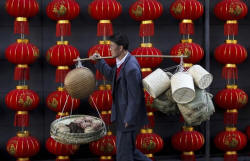China survey puts services growth at 21-month low, blurs
picture of resilient economy
 Send a link to a friend
Send a link to a friend
 [October 09, 2017]
By Elias Glenn [October 09, 2017]
By Elias Glenn
BEIJING (Reuters) - Activity in China's
services sector grew at its slowest pace in 21 months in September as
new orders cooled, a private survey showed, blurring the picture of how
the economy is performing heading into a key Communist Party Congress.
The findings of the Caixin/Markit survey reinforce views that China's
smaller companies are continuing to struggle, while large state-owned
giants are apparently reaping most of the benefits from a year-long,
government-led construction boom.
However, many analysts believe China's robust industrial rally cannot be
sustained much longer, putting pressure on policymakers to finds ways to
energize the lackluster private sector, which accounts for over half of
the country's investment and jobs.
The central bank threw a fresh lifeline to smaller firms on Sept. 30 in
an attempt to redress that deep structural imbalance, offering an
earnings booster to banks if they ramp up lending to more vulnerable
sectors of the economy.
China is counting on growth in services, particularly high value-added
services in finance and technology, to reduce the economy's traditional
reliance on heavy industry and investment.

But Monday's private survey suggested many services firms are facing a
bumpy ride.
The Caixin/Markit services purchasing managers' index (PMI) fell to 50.6
in September, the lowest reading since December 2015 and one of the
weakest since the survey began in 2005.
A reading above 50 indicates growth, and any lower signals contraction.
The index had hit a three-month high in August.
To be sure, the private findings were in sharp contrast to official data
which showed services activity expanded at the fastest clip since 2014
in September.
But an official factory survey showed a similar trend, with big
companies seeing strong improvements in business conditions while
smaller ones struggled to grow, exposing a key fault line underneath the
rosy headline growth numbers.
Still, Capital Economics' China economist Julian Evans-Pritchard, who
has been among those predicting a broader slowdown, said it was too
early to tell if the weaker Caixin service survey pointed to a turning
point just yet.
Retail sales over the just-ended Golden Week holiday rose 10.3 percent
from a year earlier, slowing but only slightly from the pace in 2016,
data showed on Monday.

[to top of second column] |

A basket vendor walks past red lanterns serving as decorations to
celebrate the new year outside a shopping mall in Kunming, Yunnan
province January 6, 2015. REUTERS/Stringer

"It is notable that there are signs of weakness in other parts of the economy
and I do think services have softened a bit...I think we will see a slowdown in
industrial production as well over the coming few months," Evans-Pritchard said.
IS RECOVERY IN THE LATE INNINGS OR EXTRA INNINGS?
After China posted forecast-beating growth of 6.9 percent in the first half,
analysts have said it was only a matter of time before it started to lose steam,
especially as the government looks to contain the risks from an explosive
build-up in debt, a campaign which is pushing up borrowing costs.
Still, economists expect September data over the next few weeks could show a
bounce in activity after a slightly softer August, welcome news for leaders
ahead of a twice-a-decade party congress that kicks off on Oct. 18.
Even if growth does start to fade, few China watchers see the risk of an
economic hard landing. Beijing should easily meet or beat its full-year growth
target of around 6.5 percent after the rousing start to the year.
"The Chinese economy generally held up well in the third quarter," Zhengsheng
Zhong, director of macroeconomic analysis at CEBM Group, said in a note
accompanying the PMI survey.
"However, the expansion in both manufacturing and services cooled in September,
suggesting downward pressure on economic growth may re-emerge in the fourth
quarter."

Separately, China reported on Monday that foreign exchange reserves rose
modestly in September for an eighth straight month, and by slightly more than
expected, as tighter regulations and a stronger yuan continued to discourage
capital outflows.
A dramatic slowdown in capital flight - which had been seen as one of the
biggest risks to China - has helped boost confidence in the world's
second-largest economy ahead of the party congress, at which President Xi
Jinping is expected to consolidate his grip on power.
(Reporting by Elias Glenn; Editing by Kim Coghill)
[© 2017 Thomson Reuters. All rights
reserved.] Copyright 2017 Reuters. All rights reserved. This material may not be published,
broadcast, rewritten or redistributed. |